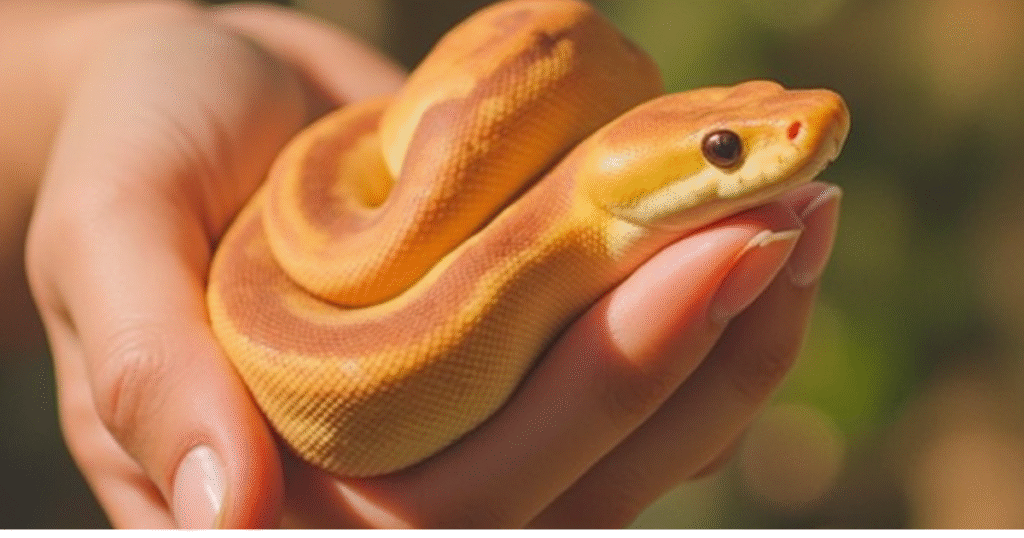Table of Contents
The mesmerizing dance of a serpent, the quiet elegance of scaled beauty, and the profound bond between human and reptile—pet snakes offer a unique companionship that captivates hearts worldwide. While traditional pets like dogs and cats dominate households, an increasing number of reptile enthusiasts are discovering the remarkable world of snake ownership.
This comprehensive guide serves as your authoritative roadmap to successful snake ownership, whether you’re a complete beginner or looking to expand your reptilian family. You’ll discover the best snakes to have as pets, learn essential care requirements, and gain the confidence needed to provide exceptional care for these fascinating creatures. From selecting your first small snakes to mastering advanced husbandry techniques, every aspect of responsible snake ownership awaits your exploration.
Understanding the Appeal: Why Choose a Pet Snake?
Unique Benefits of Snake Ownership
Snake ownership offers distinct advantages that set these reptiles apart from conventional pets:
Low Maintenance Requirements: Unlike mammals that demand daily attention, snakes thrive with minimal daily interaction. They don’t require walks, grooming, or constant companionship, making them ideal for busy lifestyles.
Space Efficiency: Even large snake species require relatively modest living spaces compared to dogs or cats. A well-designed terrarium can house most species comfortably in any home.
Quiet Companions: Snakes produce no noise, making them perfect for apartments, shared living spaces, or noise-sensitive environments.
Longevity: Many snake species live 15-30 years with proper care, offering decades of companionship and reducing the heartbreak of frequent pet loss.
Educational Value: Observing snake behavior, feeding responses, and natural instincts provides fascinating insights into reptilian biology and evolution.
Potential Challenges & Responsibilities
Responsible ownership requires acknowledging the challenges:
- Feeding Requirements: Most snakes consume whole prey items (frozen/thawed rodents), which some owners find disturbing
- Temperature Regulation: Precise heating and cooling systems are essential for snake health
- Long-term Commitment: Decades-long lifespans require unwavering dedication
- Veterinary Care: Finding qualified exotic veterinarians can be challenging and expensive
- Legal Considerations: Some locations restrict or prohibit snake ownership
Choosing Your Companion: Popular Pet Snake Species
Key Considerations Before Choosing
Before selecting your snake companion, evaluate these critical factors:
| Factor | Consideration |
| Size | Adult length determines enclosure requirements and handling difficulty |
| Temperament | Docile species suit beginners; defensive species require experience |
| Care Level | Humidity, temperature, and feeding complexity vary significantly |
| Diet | Prey size and feeding frequency impact long-term costs |
| Lifespan | Consider your commitment capacity over decades |
| Space | Enclosure size requirements for adult specimens |
| Cost | Initial purchase, setup, and ongoing maintenance expenses |


Detailed Species Profiles
Corn Snake
Pantherophis guttatus
The corn snake stands as the quintessential beginner snake, combining stunning visual appeal with remarkable hardiness. These North American natives reach 3-5 feet in length and showcase incredible color variations, from classic orange and red patterns to exotic morphs like snow, amelanistic, and charcoal.
Key Characteristics:
- Temperature range: 75-85°F with basking spot at 88°F
- Humidity: 40-50%
- Feeding: Appropriately-sized mice every 7-10 days
- Temperament: Typically docile and tolerant of handling
Ball Python
Python regius
Ball pythons earn their name from their defensive behavior of curling into a tight ball when threatened. These West African natives are among the most popular pet snakes globally, prized for their calm demeanor and incredible morph diversity.
Key Characteristics:
- Adult size: 3-5 feet
- Temperature range: 78-80°F cool side, 88-92°F warm side
- Humidity: 50-60%
- Feeding: Mice or rats every 1-2 weeks
- Special considerations: Can be picky eaters, requiring patience during feeding strikes
Kingsnake/Milksnake
Lampropeltis species
Kingsnakes and milksnakes represent hardy, adaptable species perfect for intermediate keepers. These constrictors display remarkable pattern diversity and possess fascinating natural immunity to venomous snake bites.
Key Characteristics:
- Size range: 2-6 feet depending on species
- Temperature: 75-85°F gradient
- Humidity: 40-60%
- Diet: Rodents, occasionally other snakes in nature
- Temperament: Generally calm but can be defensive when young
Rosy Boa
Lichanura trivirgata
The rosy boa is a great option for those looking for a small, gentle snake that’s easy to care for.
These southwestern United States natives adapt well to captivity and rarely exceed 3 feet in length.
Key Characteristics:
- Adult size: 2-3 feet
- Temperature: 75-85°F gradient
- Humidity: 30-50% (lower than most species)
- Feeding: Small mice every 10-14 days
- Behavior: Extremely docile and slow-moving
Hognose Snake
Heterodon species
Hognose snakes captivate owners with their dramatic defensive displays, including flattening their necks, hissing loudly, and even playing dead. These small snakes possess incredible personality and make engaging pets for experienced beginners.
Key Characteristics:
- Size: 14-24 inches
- Temperature: 75-85°F gradient
- Humidity: 30-50%
- Diet: Mice (may require scenting for picky eaters)
- Special trait: Elaborate defensive behaviors
Brief Mention of Intermediate/Advanced Species: Boa constrictors, Burmese pythons, and reticulated pythons require significant experience, specialized housing, and advanced husbandry knowledge. These species suit dedicated keepers with substantial reptile experience.
Beginner-Friendly Snakes: Your First Reptile Friend
Why These Species Are Recommended
Beginner-friendly snakes share common characteristics that ease the transition into reptile keeping:
- Forgiving temperature and humidity requirements
- Consistent feeding responses
- Docile temperaments
- Readily available captive-bred specimens
- Established care protocols
Top 5 Recommendations
- Corn Snake: The gold standard for beginner snakes, offering hardiness, beauty, and excellent temperament
- Ball Python: Slightly more demanding but incredibly rewarding, with stunning morph options
- Rosy Boa: Perfect for smaller spaces and those preferring diminutive species
- Kenyan Sand Boa: Hardy, small, and uniquely adapted for sand substrate enthusiasts
- Western Hognose Snake: Personality-packed small snakes with entertaining behaviors
Important Considerations for First-Timers
“The best snake for you is the one whose care requirements match your commitment level and lifestyle constraints.” – Reptile Husbandry Expert
Research extensively before purchasing, establish relationships with exotic veterinarians, and prepare complete setups before bringing your snake home. Consider starting with captive-bred specimens from reputable breeders rather than wild-caught animals.
The Ultimate Snake Care Guide
Enclosure Setup
Tank Type & Size
- Juveniles: 20-gallon long tanks suffice for most species
- Adults: 40-gallon breeder tanks minimum for medium species
- Large Species: Custom enclosures or 75+ gallon tanks required
- Security: Tight-fitting, ventilated lids prevent escapes
Substrate
Popular substrate options include:
- Aspen shavings: Excellent for burrowing species, holds burrows well
- Cypress mulch: Retains humidity, natural appearance
- Paper towels: Sterile, easy cleaning, ideal for quarantine
- Avoid: Cedar, pine, or aromatic woods that can cause respiratory irritation
Heating (Critical: Thermostats)
Proper heating creates essential temperature gradients:
- Heat sources: Under-tank heaters, ceramic heat emitters, radiant heat panels
- Thermostats: Absolutely essential for preventing overheating and burns
- Temperature monitoring: Digital thermometers with probes for accurate readings
- Gradient creation: Warm side (basking area) and cool side refuge
Lighting
Most snake species don’t require UVB lighting, but some benefits include:
- Day/night cycles: LED lighting establishes natural rhythms
- Plant growth: If using live plants in bioactive setups
- Viewing enhancement: Improves observation and photography
Humidity
Species-specific humidity requirements vary dramatically:
- Measurement: Digital hygrometers provide accurate readings
- Adjustment methods: Water bowl size, substrate moisture, ventilation control
- Monitoring: Consistent levels prevent shedding problems and respiratory issues
Hides
Multiple hiding spots reduce stress:
- Warm side hide: Allows thermoregulation while feeling secure
- Cool side hide: Provides temperature options
- Humid hide: Contains moist substrate for shedding assistance
- Size considerations: Snug fit promotes security without restricting movement
Water Dish
- Size: Large enough for soaking but not swimming
- Cleaning: Weekly water changes prevent bacterial growth
- Placement: Cool side placement prevents excessive evaporation
Climbing & Enrichment
- Branches: Secure climbing opportunities for arboreal tendencies
- Fake plants: Visual barriers and environmental complexity
- Varied textures: Different substrates and surfaces promote natural behaviors
Feeding Your Snake
Prey Type
- Frozen/thawed rodents: Safest option, eliminates injury risk
- Size guidelines: Prey width should match snake’s thickest body section
- Quality sources: Reputable suppliers ensure proper nutrition and safety
Feeding Schedule
| Snake Age | Feeding Frequency |
| Hatchlings | Every 5-7 days |
| Juveniles | Every 7-10 days |
| Adults | Every 10-14 days |
| Large Adults | Every 2-3 weeks |
Feeding Technique
- Tong feeding: Prevents accidental bites and reduces handling stress
- Consistent timing: Establishes routine and reduces anxiety
- Post-feeding handling: Wait 48-72 hours before handling to prevent regurgitation
Troubleshooting Hunger Strikes
Common causes and solutions:
- Seasonal variations: Many species naturally reduce feeding during winter
- Stress factors: New environments, excessive handling, inadequate hiding spots
- Temperature issues: Incorrect heating disrupts digestion and appetite
- Breeding season: Adults may refuse food during reproductive cycles
Handling Your Snake
Proper handling techniques ensure safety for both owner and snake:
- Support the body: Never grab or lift by tail or head alone
- Calm movements: Sudden motions trigger defensive responses
- Reading body language: Defensive postures indicate handling should cease
- Frequency limits: 2-3 times weekly maximum to prevent stress
Shedding & Hydration
Shedding cycles occur every 4-8 weeks:
- Pre-shed indicators: Cloudy eyes, dull coloration, increased hiding
- Humidity increase: Temporary elevation assists healthy shed completion
- Assistance: Provide humid hides and rough surfaces for rubbing
- Post-shed inspection: Ensure complete shed, especially tail tips and eye caps
Cleaning & Hygiene
Regular maintenance prevents health issues:
- Spot cleaning: Remove waste immediately upon discovery
- Deep cleaning: Monthly complete substrate replacement and disinfection
- Water bowl: Weekly cleaning with reptile-safe disinfectants
- Quarantine protocols: New snakes require 60-90 day isolation periods
Common Health Issues & When to See a Vet
Signs of a Healthy Snake
Healthy snakes display:
- Clear, bright eyes (except during shed cycle)
- Regular feeding responses
- Appropriate body weight and muscle tone
- Clean mouth without discharge
- Regular shedding cycles
- Alert, responsive behavior
Common Ailments
Respiratory Infection (RI)
Symptoms: Mouth breathing, wheezing, nasal discharge, lethargy Causes: Inadequate temperatures, poor ventilation, high humidity Treatment: Veterinary intervention required; antibiotics typically prescribed
Stomatitis (Mouth Rot)
Symptoms: Red, swollen gums, yellowish discharge, difficulty feeding Causes: Poor hygiene, stress, inadequate temperatures, injury Treatment: Professional veterinary care essential; may require surgery
Parasites (Mites, Ticks)
Symptoms: Visible parasites, excessive soaking, restless behavior Causes: Poor quarantine protocols, contaminated substrate Treatment: Specialized antiparasitic treatments under veterinary guidance
Scale Rot
Symptoms: Discolored belly scales, blistering, foul odor Causes: Excessive moisture, poor substrate conditions, inadequate cleaning Treatment: Environmental corrections and topical treatments
Regurgitation
Symptoms: Vomiting partially digested prey items Causes: Handling too soon after feeding, temperature fluctuations, stress Treatment: Withhold feeding 10-14 days, address underlying causes
Finding an Exotic Veterinarian
Locate qualified reptile veterinarians before emergencies arise:
- Veterinary associations: Search exotic animal veterinary directories
- Reptile communities: Local herpetological societies provide recommendations
- Emergency planning: Identify 24-hour exotic animal clinics
- Regular checkups: Annual health examinations prevent minor issues from becoming serious
Responsible & Ethical Snake Ownership
The Long-Term Commitment
Snake ownership represents a decades-long responsibility requiring:
- Financial planning: Ongoing costs include food, utilities, veterinary care, and equipment replacement
- Life changes: Consider housing moves, career changes, and family expansion
- Emergency preparedness: Backup heating sources, alternative housing arrangements
- End-of-life planning: Ethical considerations for aging or terminally ill animals
Handling & Welfare
Ethical snake keeping prioritizes animal welfare:
- Stress reduction: Minimize unnecessary handling and environmental disturbances
- Natural behaviors: Provide opportunities for species-appropriate activities
- Environmental enrichment: Regularly update enclosure layouts and enrichment items
- Observation skills: Learn to interpret snake body language and stress signals
Legalities & Conservation
Responsible ownership includes legal compliance:
- Local regulations: Research municipal, state, and federal restrictions
- Permit requirements: Some species require special permits or licenses
- Conservation support: Purchase captive-bred animals to reduce wild collection pressure
- Education advocacy: Share accurate information to combat negative stereotypes
Debunking Myths About Pet Snakes
Common misconceptions require correction:
“Snakes are not aggressive by nature—they are defensive creatures that prefer escape over confrontation.”
Myth: Snakes are slimy and cold Reality: Snake skin feels warm and dry, like leather
Myth: Snakes are dangerous pets Reality: Non-venomous pet species pose minimal risk with proper handling
Myth: Snakes don’t bond with owners Reality: While different from mammalian bonding, snakes recognize individual scents and handling patterns
Conclusion
The journey into snake ownership opens doors to a fascinating world where ancient reptilian wisdom meets modern care techniques. From selecting your first corn snake to mastering the nuances of ball python husbandry, each step builds expertise and deepens appreciation for these remarkable creatures.
Remember that successful snake keeping combines scientific knowledge with attentive observation, patience with consistency, and respect with genuine care. The best snakes to have as pets are those whose needs align with your capabilities and commitment level.
Whether you choose small snakes like hognose species or larger companions like ball pythons, your dedication to proper husbandry will reward you with years of quiet companionship and endless learning opportunities.
Take the next step in your reptilian journey by connecting with local herpetological societies, researching reputable breeders, and preparing your perfect snake habitat. Your scaly companion awaits, ready to share decades of silent wisdom and subtle beauty.
Ready to begin your snake ownership adventure? Start by researching local exotic veterinarians and connecting with experienced keepers in your area—your future serpentine friend will thank you for the preparation.




